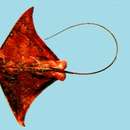Diagnostic Description
provided by Fishbase
This small species of Aetomylaeus (reaching to about 72.0 cm DW) is distinguished by the following set of characters: dorsal surface is greyish brown with a series of usually 8 (sometimes 7) transverse pale bluish bands (which are sometimes faint), no dark spots or blotches; ventral surface is whitish, pectoral fins is dusky distally; tail is rather long (1.4-1.8 times DW); without stinging spine; short and narrow head; fleshy rostral lobe, relatively broad, short, with a rounded apex; teeth usually in 7 rows in each jaw, with a broad median row flanked by 3 smaller rows on each side; dorsal-fin origin level with pelvic-fin insertions; radials of pectoral-fin 84-88 (excluding concealed propterygial radials anterior of eyes); total vertebral centra (including synarcual) 83-93; males have 16-19 pelvic radials (excluding clasper); females have 20 or 21 pelvic radials (Ref. 103981).
- Recorder
- Estelita Emily Capuli
Life Cycle
provided by Fishbase
Exhibit ovoviparity (aplacental viviparity), with embryos feeding initially on yolk, then receiving additional nourishment from the mother by indirect absorption of uterine fluid enriched with mucus, fat or protein through specialised structures (Ref. 50449). Gives birth to ~4 pups; born at ~17 cm WD (Ref.58048).
Migration
provided by Fishbase
Amphidromous. Refers to fishes that regularly migrate between freshwater and the sea (in both directions), but not for the purpose of breeding, as in anadromous and catadromous species. Sub-division of diadromous. Migrations should be cyclical and predictable and cover more than 100 km.Characteristic elements in amphidromy are: reproduction in fresh water, passage to sea by newly hatched larvae, a period of feeding and growing at sea usually a few months long, return to fresh water of well-grown juveniles, a further period of feeding and growing in fresh water, followed by reproduction there (Ref. 82692).
Trophic Strategy
provided by Fishbase
Occurs inshore and offshore, from the intertidal to at least 70 m depth. May enter brackish water (Ref. 31276). Found on the continental shelf (Ref. 75154). Feeds on worms, crustaceans, snails, and bony fishes.
- Recorder
- Drina Sta. Iglesia
Biology
provided by Fishbase
Occurs inshore and offshore, from the intertidal to at least 70 m depth (Ref. 9862); over soft substrates to at least 115 m (Ref. 103981). May enter brackish water. Feeds on worms, crustaceans, snails, and bony fishes (Ref. 12951). Ovoviviparous (Ref. 50449). With litters of up to 4 young. Size at birth about 17 cm WD (Ref. 6871). Caught frequently, but in lower numbers, by bottom trawl and inshore gillnet fisheries in some areas. Utilized for its meat, but of limited value due to its small size (Ref.58048).
Importance
provided by Fishbase
fisheries: minor commercial; price category: medium; price reliability: very questionable: based on ex-vessel price for species in this family
分布
provided by The Fish Database of Taiwan
印度西太平洋,由印度、南日本到澳洲北部。臺灣各地皆產。
利用
provided by The Fish Database of Taiwan
台灣各地均產,春初至夏末產量較豐,主要漁法為底拖網,定置網亦時常捕獲,肉質尚佳,可供食用。
描述
provided by The Fish Database of Taiwan
體盤非常寬,其寬度為長度之1.67倍,吻短,上下頜有齒7列,鰓裂小型,五鰓裂約等大,背鰭一枚,小型,起點約與腹鰭末端相對,尾長,纖細如鞭狀,無尾棘。體盤背面黑褐色,有與胸鰭後緣平行之青色帶5~6條,腹面白色,散布藍色斑塊,尾具不明顯之暗褐色橫紋。
棲地
provided by The Fish Database of Taiwan
暖水域近沿海魚類,有時會出現在大洋中,常於中表層活動,而於底層覓食,以甲殼類及貝類為食。活動水深由0~70公尺水域。
Banded eagle ray
provided by wikipedia EN
The banded eagle ray (Aetomylaeus nichofii) is a species of fish in the family Myliobatidae. It is found in Australia, Bangladesh, Brunei, Cambodia, China, India, Indonesia, Japan, North Korea, South Korea, Malaysia, Myanmar, Pakistan, Papua New Guinea, the Philippines, Singapore, Sri Lanka, Taiwan, Thailand, Vietnam, possibly Maldives, and possibly Mozambique. Its natural habitats are open seas, shallow seas, and coral reefs, where it is threatened by habitat loss.
References

- license
- cc-by-sa-3.0
- copyright
- Wikipedia authors and editors
Banded eagle ray: Brief Summary
provided by wikipedia EN
The banded eagle ray (Aetomylaeus nichofii) is a species of fish in the family Myliobatidae. It is found in Australia, Bangladesh, Brunei, Cambodia, China, India, Indonesia, Japan, North Korea, South Korea, Malaysia, Myanmar, Pakistan, Papua New Guinea, the Philippines, Singapore, Sri Lanka, Taiwan, Thailand, Vietnam, possibly Maldives, and possibly Mozambique. Its natural habitats are open seas, shallow seas, and coral reefs, where it is threatened by habitat loss.
- license
- cc-by-sa-3.0
- copyright
- Wikipedia authors and editors

